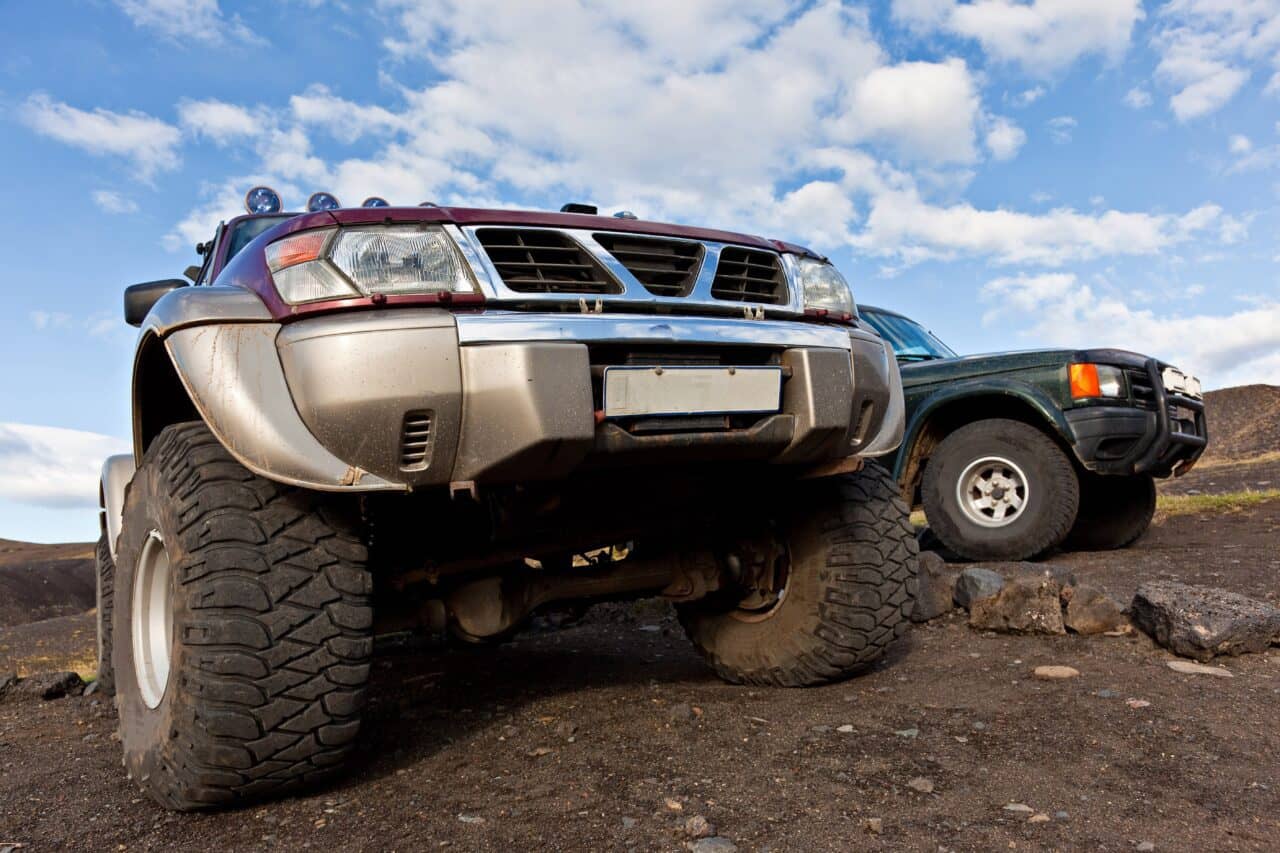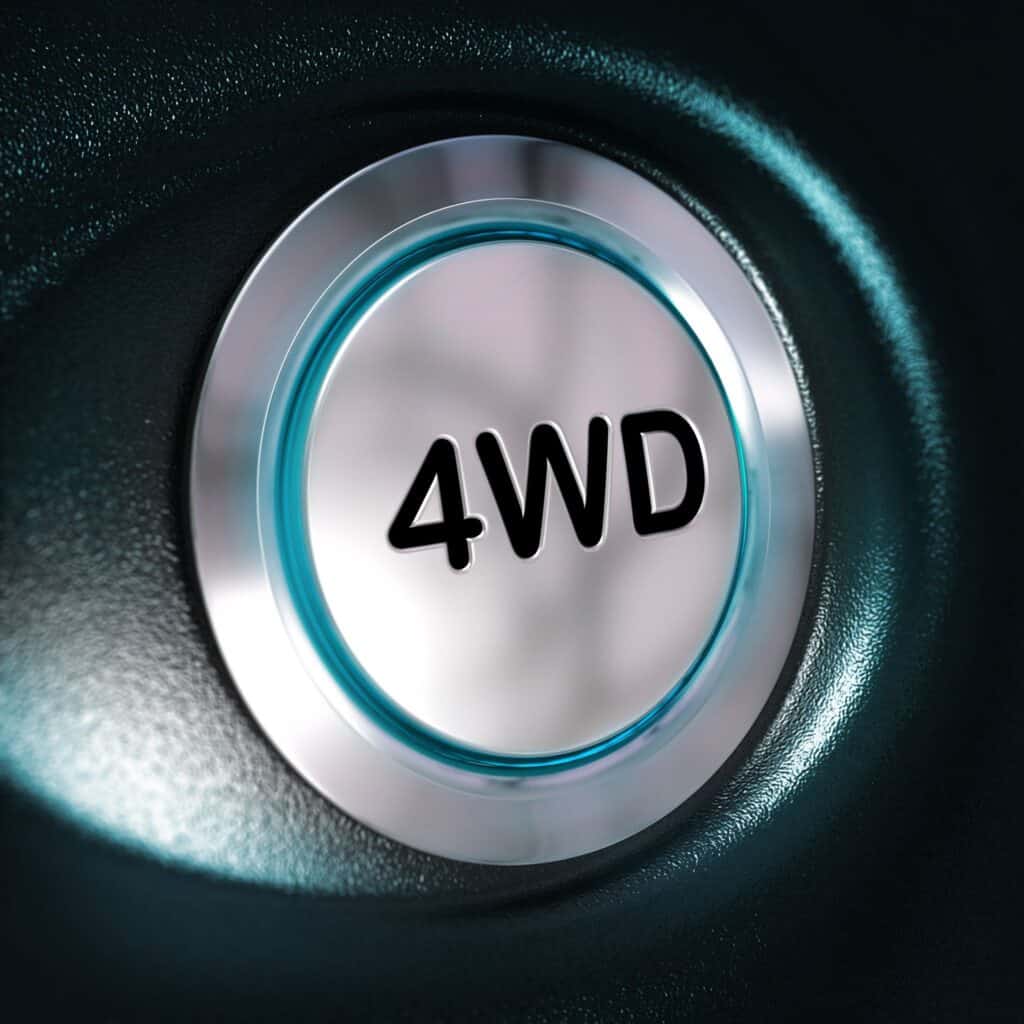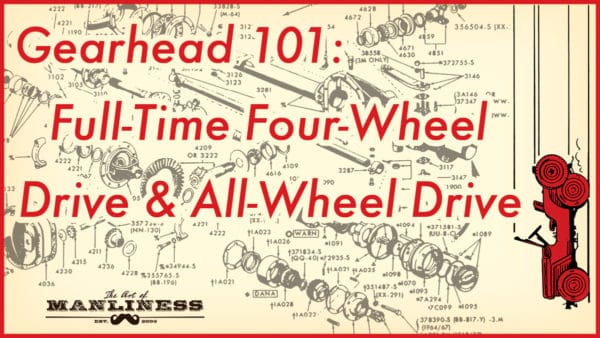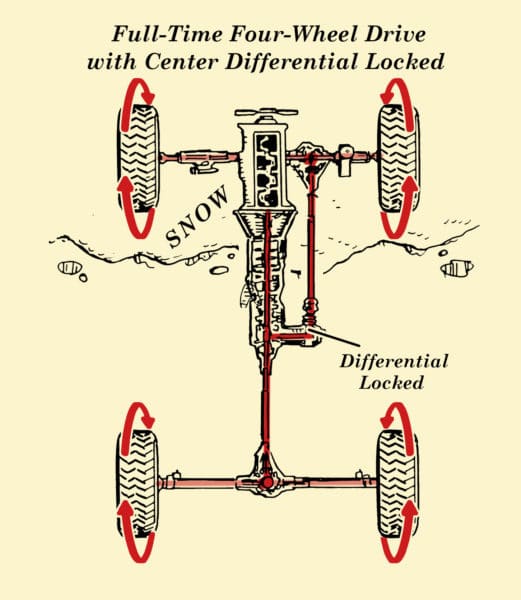Žádné placené akce! Doporučujeme pouze produkty, které se nám líbí.
Skuteční lidé! Náš tým tvoří strojní inženýři, novináři a automobiloví nadšenci s odbornými znalostmi a touhou pomáhat druhým.
Důvěryhodný zdroj! Slouží automobilové komunitě od roku 2016.

Four wheel drive and all wheel drive on the surface seem to mean the same thing. Cars have four wheels, so a car with all wheel drive should be the same thing as a car with four wheel drive. This basic conclusion seems like a perfectly legitimate deduction, but it oversimplifies something that is really much more complex than that.
4WD and AWD are not the same. In both cases, power is delivered to all four wheels at the same time, and in both cases, that power is delivered constantly. However, AWD has no capacity for low gear, making them less versatile off-road than a full-time 4WD.
4WD systems are quite complex and differ in several key ways from AWD systems. Understanding that difference is crucial in making the best choice in the vehicle for you. It will also help you in figuring out how to get the most out of your car.
How Full-Time 4WD works
In order to have a good understanding of how a full-time 4WD works, it is important to have a grasp of how a part-time 4WD works.
In simple terms, part-time 4WD vehicles function by having an engine that turns a driveshaft. That driveshaft connects to the axels which are connected to the wheels. Where the connection to the axel occurs, a differential is present, which allows different amounts of force to supply each wheel.
A problem arises here. The force from the driveshaft will always take the easiest path, so if one wheel is on a patch of ice and spinning freely, 100% of the power from the driveshaft will go to that wheel. To solve this problem, most vehicles have a differential lock option, which creates an even distribution of force.
Part-time 4WD vehicles have three primary options to drive in–two wheel drive, high four wheel drive, and low four wheel drive.
Without 4WD engaged, only the rear axle receives power from the driveshaft. For general on-road travel, this provides ample force to move the vehicle.

When entering difficult terrain, like off-road or icy conditions, the driver of the vehicle can activate 4WD which makes the drive shaft supply power to the front axle as well as the rear. This evenly distributes the force between the front and rear axels.
This is great for off-road or low traction, but bad for everyday driving because it turning with this engaged causes tension buildup in the driveshaft, which can lead to damage if it isn’t released. This happens because, with locked differentials, the wheels can’t turn at different rates, which is absolutely essential for turning.
In short, part-time 4WD causes a lot of problems if it isn’t used correctly. It can be difficult, then, to imagine how you could have full-time 4WD. The answer is having a center differential. The center differential allows for variation in force provided to the front and back axels in addition to the individual wheels.
Through this, a full-time 4WD can function almost in 2WD when necessary, or full 4WD. Like part-time 4WD, full-time 4WD has a low four wheel, or 4L, option.
This option lowers the gears the car will drive in, which allows the driveshaft to turn at one rate while the wheels turn at a lower rate. This increases torque (a fancy word for rotational force), which means the force applied to the ground by the tires increases.
This increase in force improves the ability of a vehicle to climb a steep hill. Even though the vehicle will be moving more slowly, the capacity it has to climb or maneuver other difficult terrain is greatly increased.
This was a huge set of information, and it can be really difficult to understand this sort of thing without any sort of visual aid. Because of that, I’ve linked a video that gives a general overview of 4WD systems that should help make things clearer.

Aside from the presence of a computer system governing the distribution of force amongst the wheels on the vehicle, the main difference between AWD and 4WD is the ability to use 4 Low in a 4WD car. AWD vehicles have no equivalent to 4 Low, which is their primary disadvantage.
How the Difference Impacts Performance
Obviously, there are differences in the way these two vehicle systems function, but the real question isn’t about the mechanical differences between the two, it is about the way that each system performs.
AWD vehicles are designed for driving on the road. They are great for that function, but they are limited in versatility because that is their intended function. The lack of differential locks and the absence of lower gear options limit the capacity of an all-wheel-drive vehicle.
The absence of those functions and the presence of the computer system governing operation make AWD vehicles easier to drive and compromise less on fuel economy and efficiency on the road.
Most off-road drivers agree that AWD is good for only light off-roading; heavy or intense off-road travel is too much. The compromises it makes for being optimal for road travel are inhibiting. If you drive an AWD vehicle, it’s probably best to stick to the roads and maybe hop off the beaten path now and again to find the perfect campsite, or reach your trailhead.
But if you are serious about taking the road less traveled by, the best option for you will be to pick a vehicle with 4WD. While 4WD may not have all of the advantages on pavement that AWD has, it is designed to be taken off the pavement and to go wherever you desire to go.
Differential locks and 4 Low solidify 4WD’s place as the king of off-roading. Not only will you be able to take your car off the beaten path, but you be also able to take your car off any path you want. Some vehicles can climb inclines of well over 45 degrees, which opens so many routes that are closed to any other vehicle. You will also have the ability to drive on many different surfaces–solid, irregular rock; loose grave; deep sand; and many many more.
For a more visual representation of the difference between these two systems, I’ve linked a video below. The video gives a general overview, as well as a brief demonstration of each system in action. The vehicles are set to climb a pretty basic obstacle, and each car climbs it using its system. The 4WD has a much easier time than the AWD.
The video demonstrates one of the most important distinctions between AWD and 4WD. AWD is capable of taking difficult trails, but 4WD is better at it.
If you are still in need of more inspiration, this article details the climbing of what appears to be a nearly vertical cliff close to Beijing, China. The vehicle that makes the climb is a 4WD vehicle. The article contains footage of the event, and it is quite an incredible sight to see. If I hadn’t been sold on 4WD for off-roading beforehand, this article definitely would have done it.
While AWD and full-time 4WD may seem very similar–and they are in many ways–there are a few key differences between the two. While understanding those differences can be quite complex, a good, general rule of thumb is that if you are looking for an everyday vehicle, AWD is the best option, but if you are looking for an off-road vehicle, 4WD is the car for you.

Welcome back to Gearhead 101 — a series on the basics of how cars work for the automotive neophytes out there.
Last time we went into detail about how part-time 4WD works and why it’s beneficial to have all four wheels powering the car in low-traction situations. Today, we tackle full-time 4WD, as well as All-Wheel Drive (aka AWD).
In both drivetrain systems, all four wheels power the car all the time, and as we’ll see, they accomplish that feat using a similar drivetrain arrangement. But there are also some differences between full-time 4WD and AWD, which we’ll explain below.
The Benefits and Downsides of Full-time 4WD and AWD
As we discussed in detail in our post about 4WD, one of its benefits over 2WD is that having four wheels moving all the time significantly increases traction in low-traction situations like snow, mud, and loose dirt. If, say, your rear wheels hit a low-traction area on the driving surface, your front wheels might be on a high-traction area. With them receiving power, they can help keep your vehicle moving rather than your rear wheels just spinning while your car stays stationary.
All well and good, but why would you want all four wheels receiving power from the engine even under normální driving conditions? Why would you want 4WD on plný úvazek, instead of just turning it on when needed?
The primary reason is improved handling. Having all four wheels moving the car allows it to take corners better and provides better directional stability when the car is moving in a steady state condition. Improved handling in normal driving conditions results in a safer drive. The improved handling benefit is one reason why you see AWD on sports cars and luxury sedans.
Another reason is convenience. Let’s say you’re driving on a road that has segments of ice and snow but is mostly dry. Instead of having to engage and disengage your part-time 4WD when you hit and leave those slick spots, with the four wheels going all the time, you don’t have to think about it. You just drive.
The big downside of full-time 4WD and AWD is that they use much more fuel than part-time 4WD because the engine has to transfer power to all four wheels, all the time.
How Full-time 4WD and AWD Work
So full-time 4WD and AWD have all four wheels moving the car all the time. But that raises the question: How do these drivetrain systems do that without jacking up the car when driving on high-traction driving surfaces?
As we discussed in the article about part-time 4WD, when you engage 4WD, the transfer case locks the front and rear drive shafts together. They send the same amount of power, or RPM, to the front and rear differentials. When making a turn on dry pavement the front wheels are forced by good traction and geometry to rotate faster than the rear wheels. But because the front drive shaft is going the same speed as the rear drive shaft, a large amount of tension is created that can eventually lead to what’s called drivetrain binding or windup. This can seriously damage your car.
So how do full-time 4WD and AWD avoid this problem?
By adding a third differential in the middle of the drivetrain.
Just like on part-time 4WD vehicles, full-time 4WD and AWD have both a front and rear differential on the front and rear axles that allows the left and right wheels to move at different speeds when making a turn. This prevents the wheel skip that would occur with all four wheels moving.

To prevent the drivetrain binding that would occur due to the different speeds the front and the rear wheels need to go when making a turn, a center differential is placed between the front and rear drive shafts. This allows the front and rear drive shafts to send power to both the front and rear wheels, but allows them to move at different speeds when making a turn. Drivetrain binding problem solved.
So the center differential is what allows full-time 4WD and AWD to send power to all four wheels at the same time, all the time.
What’s the difference, then, between full-time 4WD and AWD?
What Makes Full-Time 4WD Not AWD: A Locking Center Differential
Most of the time, full-time 4WD works pretty much the same way as AWD: the center differential sends engine power to both the front and rear wheels all the time. The center differential allows the front and rear drive shafts to move at different speeds, allowing the vehicle to operate normally, even when making turns on normal driving surfaces.
But by allowing the wheels to move at different speeds, you sacrifice some traction in the process, particularly in low-traction conditions like mud, snow, and dirt. This is particularly the case if the center differential is an open differential. Recall from our previous article that the power flow of open differentials follows the path of least resistance. In low-traction settings, this is no bueno. Here’s why.

Let’s say you’re in a full-time 4WD or AWD vehicle with a center open differential. You’re driving up your driveway, and the front wheels hit a patch of icy snow. You think “I’ve got AWD! This shouldn’t be a problem.” But it is. Those front wheels have the least amount of traction, and consequently represent the path of least resistance. So the center differential is going to send all the power to the front wheels, causing them to spin in place while your rear wheels just sit there on dry pavement not moving at all. To get up the driveway, it’d be nice to have those rear wheels getting some power.
To solve this problem, most full-time 4WD and AWD vehicles use a limited-slip (LSD) or Torsen center differential. These types of differentials give you the benefit of open center differentials — allowing the front and rear wheels to move at different speeds when making a turn on dry pavement — but when one set of wheels hits a slick part, instead of sending all the power to those wheels, it will still send some power to the ones on dry pavement.
So in our snowy driveway scenario, a full-time 4WD or AWD vehicle with a center LSD would send some of the engine’s power to the rear wheels that have traction instead of all of it to just the front wheels that have no traction, allowing you to get your car up the driveway.
Limited slip differentials definitely improve traction compared to open differentials. For most 4WD scenarios, LSDs are all you need for adequate traction. But LSDs still don’t provide optimální traction because most of the power is still going to the wheels with less traction. There’s still a chance of wheel slip.
This is where full-time 4WD separates itself from AWD. Full-time 4WD vehicles have a locking center differential that’s built into the transfer case. When a driver engages it, the center differential locks the front and rear drive shafts together so that they turn at the same speed thus delivering equal amounts of torque to the rear and front wheels. Basically, a full-time 4WD vehicle with the center differential locked acts like a part-time 4WD vehicle when the 4WD is engaged.

In our snowy driveway scenario, a full-time 4WD vehicle with the center differential locked will send equal amounts of power to both the front and rear wheels. Instead of the rear wheels not moving at all (like on an open center differential), or just a bit (like on a center LSD), the rear wheels will be moving at a good clip, allowing you to get your vehicle safely up the driveway.
Some full-time 4WD vehicles increase the traction capabilities in low-traction settings by having options to lock the rear differential, or even both the front and rear differentials, turning the vehicle into a pravdivý 4 × 4.
Many full-time 4WD vehicles also have the option to shift to Lo-gear, allowing you to deliver more power to your wheels while going at lower speeds.
Just as you wouldn’t want to have both front and rear drive shafts moving at the same speed in a part-time 4WD vehicle when on normal driving surfaces, you don’t want them moving at the same speed in a full-time 4WD vehicle when on normal driving surfaces either. You’ll want to disengage the locked center differential when you’re on high-traction surfaces.
AWD vehicles don’t have the option for a locking center differential, so they don’t provide as much traction in slippery scenarios as 4WD vehicles. While AWD can help improve handling on normal driving surfaces, and can improve traction on rainy roads and a bit on snow-covered roads, you wouldn’t want to take an AWD vehicle off-roading. That’s what trusty 4WD is for.
Well, there you go. The basics of how full-time 4WD and AWD work. With that, we’ve pretty much covered the drivetrain on a car. Next up in our Gearhead 101 series: the transmission.















